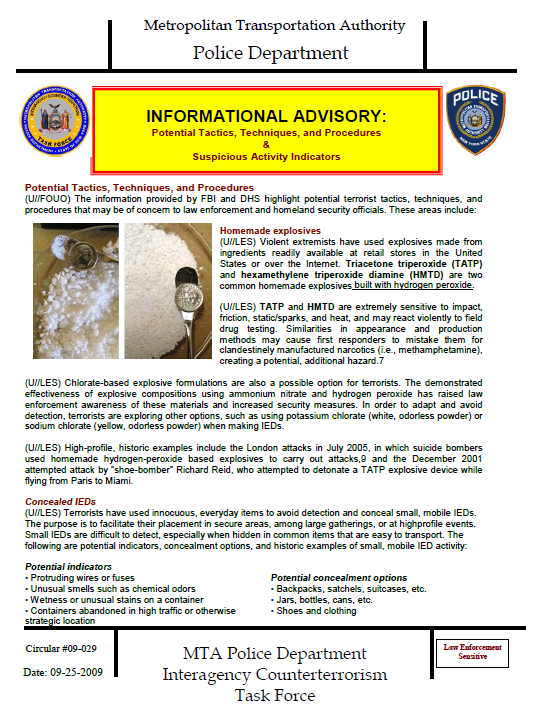 New York Metropolitan Transportation Authority
New York Metropolitan Transportation Authority
- MTA Police Department Interagency Counterterrorism Task Force
- 2 pages
- Law Enforcement Sensitive
- For Official Use Only
- September 25, 2009
Potential Tactics, Techniques, and Procedures
(U//FOUO) The information provided by FBI and DHS highlight potential terrorist tactics, techniques, and procedures that may be of concern to law enforcement and homeland security officials. These areas include:
Homemade explosives
(U//LES) Violent extremists have used explosives made from ingredients readily available at retail stores in the United States or over the Internet. Triacetone triperoxide (TATP) and hexamethylene triperoxide diamine (HMTD) are two common homemade explosives built with hydrogen peroxide.
(U//LES) TATP and HMTD are extremely sensitive to impact, friction, static/sparks, and heat, and may react violently to field drug testing. Similarities in appearance and production methods may cause first responders to mistake them for clandestinely manufactured narcotics (i.e., methamphetamine), creating a potential, additional hazard.
(U//LES) Chlorate-based explosive formulations are also a possible option for terrorists. The demonstrated effectiveness of explosive compositions using ammonium nitrate and hydrogen peroxide has raised law enforcement awareness of these materials and increased security measures. In order to adapt and avoid detection, terrorists are exploring other options, such as using potassium chlorate (white, odorless powder) or sodium chlorate (yellow, odorless powder) when making IEDs.
(U//LES) High-profile, historic examples include the London attacks in July 2005, in which suicide bombers used homemade hydrogen-peroxide based explosives to carry out attacks,9 and the December 2001 attempted attack by “shoe-bomber” Richard Reid, who attempted to detonate a TATP explosive device while flying from Paris to Miami. Concealed IEDs
(U//LES) Terrorists have used innocuous, everyday items to avoid detection and conceal small, mobile IEDs. The purpose is to facilitate their placement in secure areas, among large gatherings, or at highprofile events. Small IEDs are difficult to detect, especially when hidden in common items that are easy to transport. The following are potential indicators, concealment options, and historic examples of small, mobile IED activity:
Potential indicators
• Protruding wires or fuses
• Unusual smells such as chemical odors
• Wetness or unusual stains on a container
• Containers abandoned in high traffic or otherwise strategic locationPotential concealment options
• Backpacks, satchels, suitcases, etc.
• Jars, bottles, cans, etc.
• Shoes and clothing…
Suspicious Activity Indicators
(U//LES) Suspicious activity is not always actionable, but when placed in context with additional behaviors or with other information, may indicate a potential threat. The following are some examples of potential suspicious activity:
General
• There is no typical physical appearance for a terrorist operative – al-Qaeda actively seeks to diversify its “operatives”
• Bulky clothing inconsistent with the weather; frequent, brief contact with other individuals; etc.
• Individuals taking panoramic photos/videos – the al-Qaeda Manual emphasize that if still photos are taken, prints should be cut and assembled together in a mosaic
• Individuals taking notes or drawing diagrams of critical infrastructure
• Repeat visits to take photos/video of the same landmark
• Measuring by counting footsteps between entrances, security posts, security cameras, etc.
• Questioning security personnel on sensitive subjects (shift changes, what cameras film, etc.).
• Possession of multiple identification documents
• Filming entry and egress points, traffic barriers, or security personnel
• Possession of sensitive schedules, blueprints, evacuation plans, codes, etc.Homemade explosives
• Individuals who have burn marks on their hands, arms, or face, or who have stains on clothing
• Foul odors or caustic fumes coming from a room or building
• Damage to ceilings and walls – such as corrosion of metal surfaces or structural damage – and paint discoloration from harsh chemical fumes
• Strong chemical odors emanating from sewers and drainage ditches
• Large industrial fans or multiple fans in windows
• Dead vegetation in the surrounding area
• Presence of metal or plastic drums for storing explosives
• Machinery – such as gas burners or mixers – for processing raw materials
• Discoloration of pavement, soil, or structure
• Refrigerators or coolers used to store volatile chemicals and finished products
• Individuals requesting or purchasing information (such as textbooks) on using peroxide
• Large-quantity purchases of hydrogen peroxide (i.e., more than a gallon)
